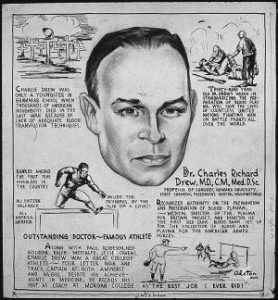你生病有血可用,应该感谢他
100多年前的今天(6月3日),黑人医生查尔斯·德鲁(Charles Drew)出生。他是保存血浆的方法的发明者
撰文 | 黄雪
100多年前的今天,一位黑人医生查尔斯·德鲁(Charles Drew)出生了。你可能对他的名字十分陌生,但是他发明了保存血浆的方法,以及组织、建造了美国第一个大型血库,他是血液王国中名副其实的黑人英雄。
《旧约全书》中的《利未记》说过:肉体的生命在血液之中。由此可见,自古以来人们就认识到了血液的重要性。在古代,人们对血液盲目崇拜,他们认为饮血或用血液来沐浴可以恢复体力、治愈疾病,甚至幻想以此来返老还童。如今,大家对于临床上输血已经司空见惯了,输血、输血反应以及溶血知识也成为医生的常识。然而,血液极易变质,难以保存。人类在输血之初就对血液的储存有需求。而只有到了德鲁出现才真正满足了这个需求。
1904年,德鲁出生于美国华盛顿特区一个非洲裔中产阶级家庭。他从小就表现出在体育上的天赋。8岁时,他在游泳比赛中获得了4枚奖牌;高中时,他获得了全能运动成绩,被评为“最佳运动员”、“最受欢迎的学生”等;高中毕业后,德鲁拿着体育奖学金奔赴马萨诸塞州阿默斯特学院。
本可以在体育道路上越走越远的德鲁,因受到他的生物学教授奥托·格拉泽(Otto Glaser)的激励,以及他年幼的妹妹死于肺结核事件的触动,决定选择医学作为自己的职业。一开始,德鲁在医学的道路上并不顺利,他面临着没钱以及种族歧视的窘境。但经过他不懈地坚持与努力,于1928年顺利申请到医学院校,就读于加拿大麦吉尔大学。不同于美国,加拿大人并不在意德鲁的肤色,在这种环境下,他更加轻松、全身心地投入到医学研究领域。
德鲁的很多研究都专注于那个时代极具挑战性的医学问题:如何使“血液银行”随时根据需要输血。由于缺乏相关技术,血液离开人体后极易变质,通常需要人们定期捐献新鲜血液,但是在找到匹配的血型之前,大多数病人就死亡了。这个问题引起了德鲁的深切关注,他觉得医院应该有一种方法来存储新鲜血液以备急用。
于是德鲁开始研究血浆,他发现血浆中含有多种蛋白质和电解质,能够保存较长时间,在运输过程中搅动也不会恶化,能很好地替代液体、治疗休克。尤其是在紧急或战斗情况下,已超过全血的优势。
但极为讽刺的是,在德鲁为美国血库做出了如此大贡献并且效力于红十字会时,相关政策却规定,红十字会献血排除非裔美国人。虽然该政策很快就被修改,接受来自黑人的献血,但要求将其献的血与白人的血相隔离,只能用于非洲裔士兵。德鲁对这种种族歧视政策感到愤怒,他批评这些政策侮辱了非裔美国人,并毅然辞职。
1950年,在一场车祸中,德鲁的生命戛然而止。关于德鲁之死的传说总是围绕着输血展开——据说他因没有得到输血而死,但这些传说后来都被辟谣了。虽然存在种族歧视,但科学永远无界限,德鲁为人类作出的贡献,将永远记载于科学史册。
参考资料:
1. http://www.sciencedirect.com/science/article/pii/S0140673615013586
2. http://history1900s.about.com/od/scientists/fl/Dr-Charles-Drew.htm
3. https://profiles.nlm.nih.gov/ps/retrieve/Narrative/BG/p-nid/336
4. http://www.biography.com/people/charles-drew-9279094
来源于 财新网

Portrait
At a time when millions of soldiers were dying on battlefields across Europe, the invention of Dr. Charles R. Drew saved countless lives. Drew realized that separating and freezing the component parts of blood would enable it to be safely reconstituted later. This technique led to the development of the blood bank.
Drew was born on June 3, 1904 in Washington, D.C. Charles Drew excelled in academics and sports during his graduate studies at Amherst College in Massachusetts. Charles Drew was also a honor student at McGill University Medical School in Montreal, where he specialized in physiological anatomy.
Charles Drew researched blood plasma and transfusions in New York City, where he became a Doctor of Medical Science — the first African-Americanto do so at Columbia University. There, he made his discoveries relating to the preservation of blood. By separating the liquid red blood cells from the near solid plasma and freezing the two separately, he found that blood could be preserved and reconstituted at a later date.
How To Negotiate Your Bills Lower
Blood Banks and World War II
Charles Drew's system for the storing of blood plasma (blood bank) revolutionized the medical profession. Dr. Drew was chosen to set up a system for storing blood and for its transfusion, a project nicknamed "Blood for Britain.” This prototypical blood bank collected blood from 15,000 people for soldiers and civilians in World War II Britain, and paved the way for the American Red Cross blood bank, of which he was the first director. In 1941, the American Red Cross decided to set up blood donor stations to collect plasma for the U.S. armed forces.
After the War
In 1941, Drew was named an examiner on the American Board of Surgeons, the first African-American to do so. After the war, Charles Drew took up the Chair of Surgery at Howard University, Washington, D.C. He received the Spingarn Medal in 1944 for his contributions to medical science. In 1950, Charles Drew died from injuries suffered in a car accident in North Carolina. He was only 46 years old. Unfounded rumor had it that Drew was ironically denied a blood transfusion at the North Carolina hospital because of his race — but this wasn’t true. Drew’s injuries were so severe that the life-saving technique he invented could not have saved his own life.